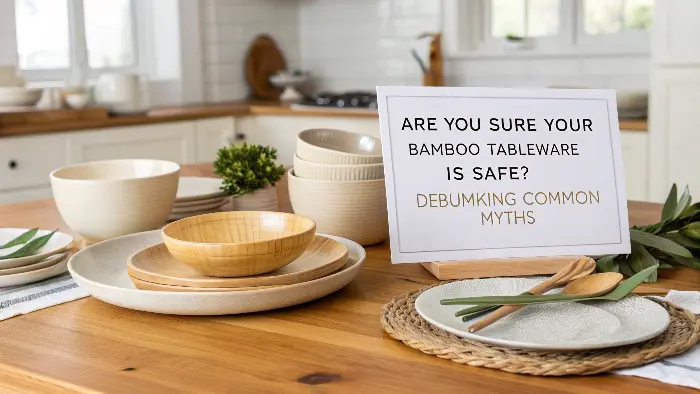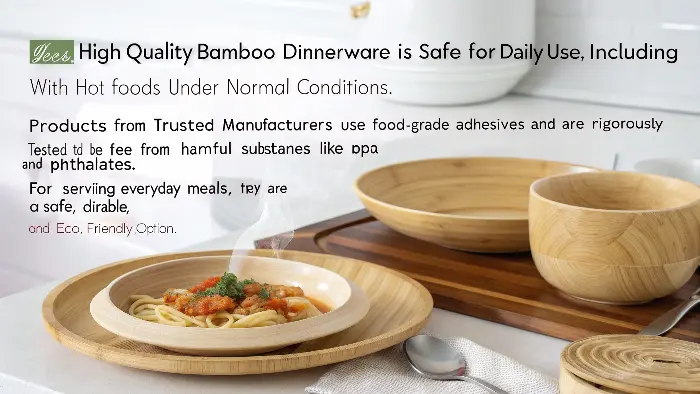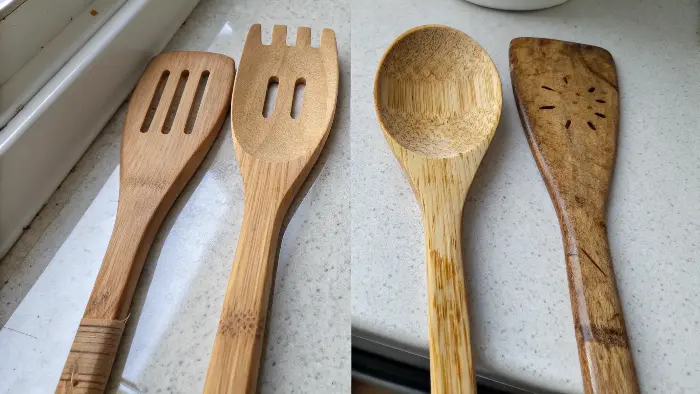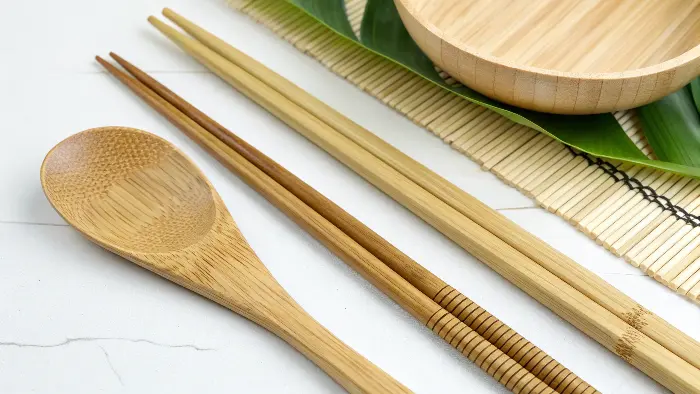You chose bamboo products for your business or home because you wanted a sustainable, eco-friendly option. But now you hear worrying stories about toxins, heat safety, and bacteria. It makes you question if you made the right call, wondering if this "green" alternative is actually safe for food contact.
High-quality bamboo tableware is generally very safe for food contact. The main safety concerns arise from low-quality products that use industrial-grade glues containing melamine and formaldehyde, which can leach under high heat. To ensure safety, always choose products from reputable suppliers who can provide food-grade certifications like FDA and LFGB. Solid bamboo items are inherently safer than composite ones, but properly made composite products are also perfectly safe for everyday use.

These concerns are completely valid, and it’s smart to ask these questions. The safety of bamboo tableware isn’t a simple yes-or-no answer; it really depends on the quality of the material and how it’s manufactured. As a product specialist at Ecosourcecn, I’ve spent years vetting suppliers and analyzing material safety reports. Let’s break down the facts so you can feel confident about the bamboo products you choose.
Is bamboo dinnerware actually safe for daily use?
You love the natural, earthy look of your bamboo plates and bowls. But you pause before serving hot soup or a steaming pasta dish on them. What if harmful chemicals from the binder leach into your family’s meal? This uncertainty can spoil the dining experience and make you second-guess your sustainable choice.
Yes, high-quality bamboo dinnerware is safe for daily use, including with hot foods under normal conditions. Products from trusted manufacturers use food-grade adhesives and are rigorously tested to be free from harmful substances like BPA and phthalates. The key is to avoid using them in the microwave or oven. Extreme heat can compromise the integrity of the binding agents, but for serving everyday meals, they are a safe, durable, and eco-friendly option.

When people ask me about the safety of bamboo dinnerware, the first thing I clarify is the type of bamboo product we’re talking about. There’s a big difference between items made from solid bamboo and those made from bamboo fiber composites. Understanding this distinction is the key to knowing what’s safe and what’s not.
Solid Bamboo vs. Composite Bamboo
Solid bamboo products are what most people picture: items carved or laminated directly from bamboo stalks. Think of cutting boards, utensils, or trays made from strips of bamboo wood glued together. In my experience, these are among the safest options. The adhesives used to laminate the strips are typically food-grade and are used in such small quantities that the risk of leaching is almost zero. These products are durable and have a natural finish.
Composite bamboo products are different. They are made by grinding bamboo fiber into a powder, then mixing it with a binding agent to mold it into shapes like plates, cups, and bowls. This is where the controversy begins. The binder is often a melamine-formaldehyde resin.
The Role of Adhesives and Binders
The safety of composite bamboo dinnerware depends almost entirely on the quality of the melamine binder. Low-quality manufacturers might use industrial-grade resin, which is not intended for food contact and can leach harmful chemicals, especially when exposed to high heat (over 70°C / 158°F) or acidic foods.
This is why, at Ecosourcecn, we are so strict about certifications. We ensure our suppliers’ products meet international standards like:
- FDA (U.S. Food and Drug Administration): Sets basic safety standards for food-contact materials.
- LFGB (Lebensmittel-, Bedarfsgegenstände- und Futtermittelgesetzbuch): A stricter German and European standard that involves more rigorous testing for chemical leaching.
Products that pass LFGB testing are a gold standard for safety.
To make it simple, here’s a breakdown:
| Feature | High-Quality Bamboo Dinnerware | Low-Quality Bamboo Dinnerware |
|---|---|---|
| Material | Solid bamboo or bamboo fiber with food-grade binder. | Bamboo fiber with industrial-grade melamine resin. |
| Binder | Food-safe, low-leaching, formaldehyde-free options. | High levels of melamine and formaldehyde. |
| Certifications | FDA, LFGB, BPA-Free. | Often uncertified or fake certifications. |
| Heat Tolerance | Safe for hot foods (not microwave/oven). | Risk of leaching chemicals above 70°C (158°F). |
| Safety | Considered very safe for daily use. | Potential health risk due to chemical migration. |
What are the real problems with bamboo utensils?
You’ve been told that bamboo utensils are the perfect green swap for plastic. But you’ve also heard they can splinter over time, absorb strong flavors, or contain hidden chemicals. This conflicting information makes it hard to know if you’re making a responsible choice or just trading one problem for another.
The main problems with bamboo utensils are almost always linked to low quality or improper care. Cheaply made items can splinter, have a rough finish, or use unsafe coatings. Another issue can be staining or flavor absorption if they are not cleaned correctly. However, well-made bamboo utensils are sanded smooth, finished with food-safe oil, and are durable enough to resist most issues when hand-washed and dried promptly.

As a sourcing specialist, I’ve seen the entire spectrum of quality in bamboo products. The cheap, poorly made utensils you might find at a discount store are worlds apart from the high-quality, certified products we specialize in. The problems are real, but they are also completely avoidable. Let’s look at the common complaints and how to solve them.
The Splintering and Durability Myth
One of the biggest fears is that bamboo utensils will splinter into your food. This only happens with extremely low-quality or old, dried-out utensils. Good quality bamboo is known for its strength and flexible fibers, making it less likely to splinter than many types of wood. To prevent this, always choose utensils that feel smooth and have a quality finish. After a lot of use, if a utensil starts to feel rough, you can lightly sand it and reapply a food-safe mineral oil to restore its finish. Proper care is key—never let them soak in water for long periods, as this can cause the fibers to swell and weaken.
Staining, Odors, and Maintenance
Another concern is that bamboo will absorb the color and smell of strong foods like curry or tomato sauce. While bamboo is more resistant to this than soft woods, it can happen if the utensil isn’t washed promptly. The solution is simple: wash your bamboo utensils by hand with warm, soapy water right after use. Don’t put them in the dishwasher, as the high heat and harsh detergents will strip their natural oils and cause them to crack or warp over time. Dry them with a towel instead of letting them air dry to prevent any chance of water damage.
Here’s a quick guide to avoiding common issues:
| Potential Problem | Why It Happens | How to Avoid It |
|---|---|---|
| Splintering | Low-quality manufacturing or utensil is old and dry. | Buy from reputable brands. Hand wash only. Occasionally rub with food-safe mineral oil. |
| Staining/Odor Absorption | Leaving the utensil to sit in strong-colored or acidic foods. | Wash immediately after use. Avoid letting it soak. |
| Warping or Cracking | Exposure to extreme heat (dishwasher) or prolonged moisture. | Hand wash and dry immediately. Never put in the dishwasher, microwave, or oven. |
| Unsafe Finish | Some cheap products use mystery lacquers or varnishes. | Choose products labeled as finished with food-safe oil or with a natural finish. Look for certifications. |
Do bamboo utensils actually hold bacteria?
The thought of bacteria growing deep in the pores of your bamboo spoon is pretty unsettling. You clean it thoroughly after every use, but you can’t help but wonder if it’s ever truly sanitary. This fear might even make you reach for plastic or metal, even though you want to make a more eco-conscious choice.
No, bamboo utensils do not hold bacteria any more than other materials when they are cared for properly. In fact, bamboo has natural antimicrobial properties that can help inhibit bacterial growth. Its surface is less porous than wood, making it more difficult for bacteria to get trapped. As long as you wash your utensils with soap and hot water after use and allow them to dry completely, they are perfectly hygienic.

This is one of the most persistent myths I encounter, and it’s one that’s worth debunking with facts. The fear of bacteria often comes from our experience with wooden cutting boards, which can get deep knife grooves that are hard to clean. However, bamboo is technically a grass, not a wood, and its structure is very different.
Bamboo’s Natural Antimicrobial Shield
Bamboo plants contain a natural antimicrobial agent sometimes referred to as "bamboo kun." This agent helps the plant resist pests and fungi in the wild. While the potency of this agent in the final, processed product is debated by scientists, the physical structure of bamboo is its real superpower. Bamboo fibers are incredibly dense and hard. This creates a surface that is naturally less porous than most woods, giving bacteria fewer places to hide and multiply. When you run your finger over a quality bamboo utensil, you can feel how smooth and non-porous it is.
Comparing Materials: Bamboo vs. Wood vs. Plastic
When we evaluate materials for kitchen use, porosity is a huge factor in hygiene. Here’s how bamboo stacks up against other common materials I’ve analyzed:
- Wood: Wooden utensils and cutting boards are quite porous. They easily absorb moisture, and knife marks can create deep crevices where bacteria thrive. This is why they require diligent cleaning and oiling.
- Plastic: New plastic utensils are non-porous and easy to clean. However, with use, they develop thousands of tiny scratches. These scratches are perfect breeding grounds for bacteria and are nearly impossible to fully sanitize, which is a major reason I advise clients to move away from plastic.
- Bamboo: Bamboo strikes a great balance. It’s harder and less porous than wood but has a slight "give" that is gentle on cookware. Because it’s so dense, it resists the deep scratches that plague plastic.
Let’s put it in a table for a clear comparison:
| Material | Porosity | Antimicrobial Properties | Best Cleaning Practice |
|---|---|---|---|
| Bamboo | Low | Contains natural antimicrobial agents. Dense surface resists bacteria. | Hand wash with soap and hot water, dry completely. |
| Wood | High | Some woods have antimicrobial oils, but high porosity is a risk. | Hand wash, dry completely, oil regularly. |
| Plastic | Non-porous when new, but becomes porous with scratches. | None. Scratches can harbor dangerous bacteria. | Dishwasher safe, but should be replaced when scratched. |
| Stainless Steel | Non-porous | None, but the smooth surface is very easy to sanitize. | Dishwasher safe. The most hygienic option. |
While stainless steel is the easiest to sanitize, bamboo is an outstanding hygienic choice for a natural material, easily outperforming both wood and used plastic.
Conclusion
Ultimately, bamboo tableware is a safe, stylish, and sustainable choice when you know what to look for. The myths about safety and bacteria often stem from bad experiences with cheap, uncertified products. By choosing items from trusted suppliers like Ecosourcecn, you can be sure you’re getting a product that is both eco-friendly and completely safe for your business or family.


